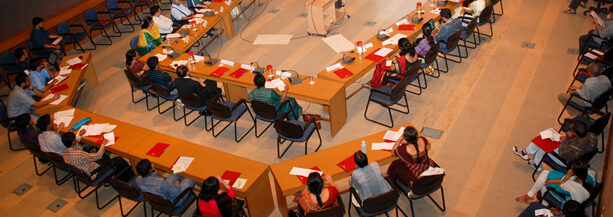
B V Sreekantan has a PhD from TIFR, Mumbai, and joined NIAS on 6th August 1992. Dr. Sreekantan is currently Visiting Professor at this Institute and also Chairman, Gandhi Centre of Science and Human Values of the Bharatiya Vidya Bhavan, Bangalore. He was Dr. Radhakrishnan Visiting Professor in 1992. He was the Director of the Tata Institute of Fundamental Research during 1975-87 and the Indian National Science Academy Srinivasa Ramanujan Professor during 1987-92. He has received a number of professional awards including the RD Birla Award of the Indian Physics Association and the Padma Bhushan. He has held a number of Visiting positions including in the US and Japan. After moving to NIAS, Prof. Sreekantan shifted his interests from pure science to studies on scientific and philosophical studies on consciousness and exploration of commonalities and similarities in holistic approaches in modern science and ancient philosophies. Through two seminars organized by him at NIAS, the historical epistemological, mathematical, experimental and technological factors that laid the foundations of sciences and led to the growth of modern science over the last few decades were analyzed and these have been incorporated in a volume that was published by ICPR.
He has specialised in cosmic rays, high-energy physics and high-energy astronomies and has published over 200 research papers. After moving to NIAS, Prof. Sreekantan shifted his interests from pure science to studies on scientific and philosophical studies on consciousness and exploration of commonalities and similarities in holistic approaches in modern science and ancient philosophies.

Physics and Consciousness
The “hard” problem of consciousness, namely the processes by which electrochemical and neurochemical signals are converted to perception, thoughts, emotions or memory, still remain unexplained despite phenomenal developments in the neurosciences. This is a kind of problem in which one category of experience familiar to us as electrical signals or chemical reactions are transformed to an entirely different kind of experience, which is attributed to consciousness. In the history of physical sciences too, similar conceptual barrier problems like emission of radiation by fast moving charged particles, emission of alpha particles by radioactive nuclei, or creation of new particles in high energy collisions could not be explained within the framework of classical physics and for which quantum mechanics had to be brought in. This also gradually led to the realisation of the role of quantum field theories in the creation of the Universe itself – the creation of space, time, radiation, particles, or forces and finally to the role of geometrical properties of higher dimensional spaces in defining the properties like mass, charge, or spin. Clearly, the hard problem of consciousness is one such if a solution has to be found within the framework of science.

Quantum Coherence
Quantum mechanical theories have been proposed in the past but a satisfactory theory still eludes us. One of the problems faced was that quantum coherence, which is an important aspect of the theory, could not be sustained at the body temperatures.
In very recent years, this objection has been overcome by the experimental observation that there are some physical phenomena in nature like photosynthesis, or homing of birds, which require quantum mechanical coherence at high enough temperatures for explanation. This is an area in which there is plenty of scope for research and for new insights.

